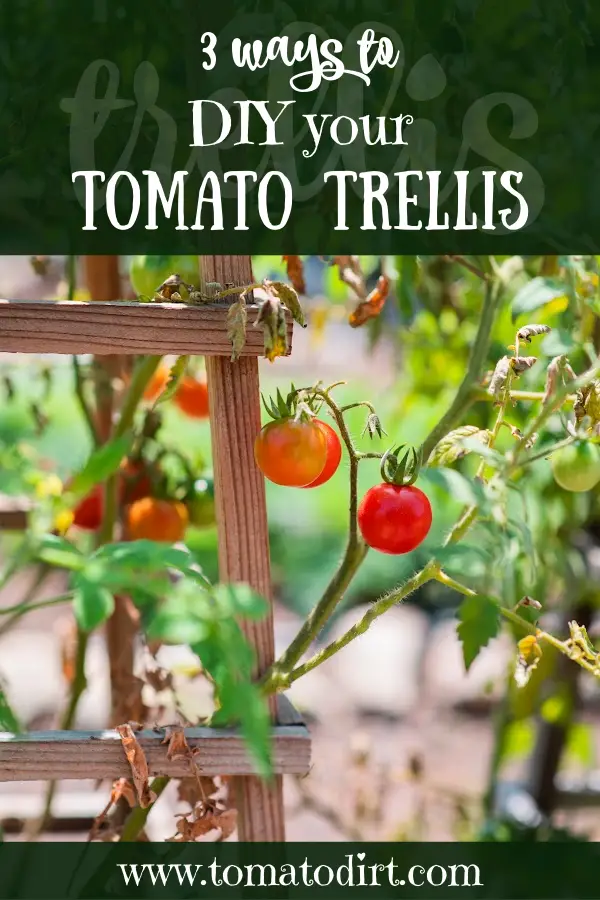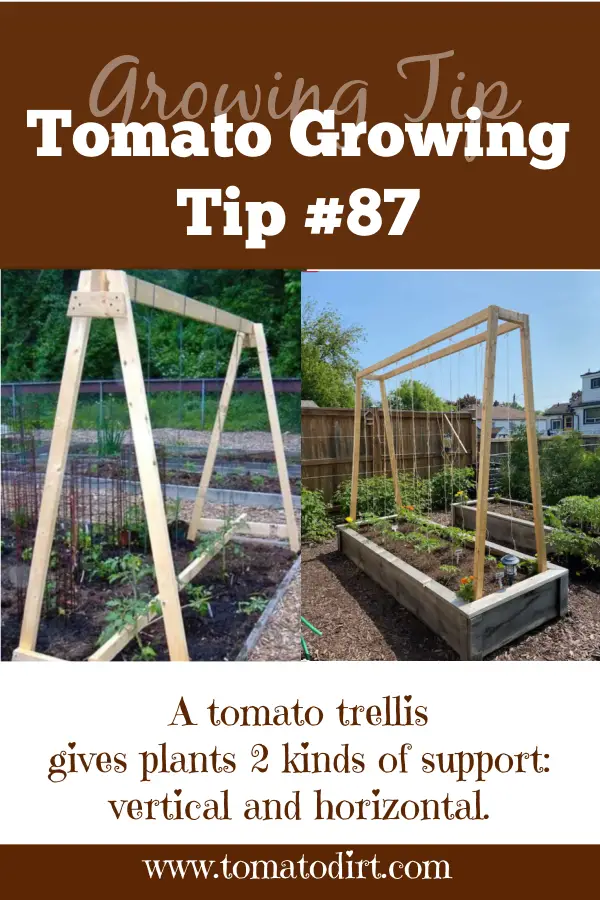FREE: 10 Must-Know Tomato Growing Tips Get The Guide
Read our affiliate disclosure here.
3 Do-It-Yourself
Tomato Trellis Ideas
Since 2010, Tomato Dirt has garnered 4.8+ million views, making it the web’s leading online source for growing tomatoes in the home garden. Award-winning writer and Tomato Dirt owner Kathy Widenhouse has helped thousands of home gardeners grow healthier tomatoes. Be one of them when you get Tomato Dirt’s Growing Guide here.
Posted 5.13.24
One of the easiest ways to stake tomatoes can also the least expensive: a do-it-yourself tomato trellis.
Trellises
are garden structures made of both vertical supports (such as stakes, poles, or
frames) paired with horizontal weaving material (like wires, mesh, or strings).
Put together, the vertical and horizontal support create a strong framework for
the tomato plants to climb and grow on. You can train tomato vines to climb the
structure and periodically tie new branches to the horizontal supports.
The two-dimensional structure makes a tomato trellis different from traditional tomato supports – specifically tomato stakes and tomato cages.
- Single tomato stakes are simple to set up and good for smaller tomato varieties or determinate types that don't grow as tall, but may not adequately support large, indeterminate tomato plants laden with heavy fruit.
- Tomato cages, meanwhile, help keep plants upright and are easy to install – but they can be expensive, particularly if you need to add extensions when large, indeterminate tomato plants spill over the cage tops.
DIY tomato trellis saves money and helps your plants
Your do-it-yourself tomato trellis is an inexpensive way to stake your tomato plants – one with distinct advantages.
- A tomato trellis saves space. Trellises encourage tomato plants to grow vertically, which gives you more room in your garden for other crops (or more tomato plants.)
- A tomato trellis improves air flow. Your tomato plants’ upward mobility means better air movement around their foliage. That reduces humidity levels (which minimizes the risk of disease like tomato blight) and prevents water and soil from splashing onto the leaves (which can harbor pathogens). Keeping the foliage off the ground also discourages pests.
- A tomato trellis increases sunlight exposure. As tomato vines grow upward, more leaves and fruit receive adequate sunlight. This can lead to healthier plants and increased fruit production. Plus, tomatoes ripen more evenly.
- A tomato trellis makes picking easier, Fruit is accessible. You can visually inspect and pick ripe tomatoes without bending or stooping as much compared to plants staked with single stakes or cages.
Another advantage: you can DIY a tomato trellis even you’re not particularly handy. All different trellis designs work well to support tomatoes and help them grow vertically, including A-frames, teepees, or grids, allowing gardeners to choose a structure that suits their garden layout and tomato varieties.
Here are three of the easiest do-it-yourself tomato trellis ideas.
Try these 3 do-it-yourself tomato trellis ideas
1. Wooden A-frame tomato trellis
What you need
- 4 wooden stakes or posts (6 to 8 feet tall)
- Wooden boards or wire mesh for the frame
- Screws or nails
- Hammer or screwdriver
- Saw (if you're cutting boards)
What to do
- Position two wooden stakes in the ground, about 3 feet apart.
- Attach a horizontal board or wire mesh across the top of the stakes to form the peak of the A-frame.
- Connect diagonal boards or wire mesh from the top of each stake to the ground to create the A-frame shape.
- Secure all pieces together with screws or nails.
Expertise level: moderate. Basic carpentry skills are required to cut and assemble the wooden components.
Advantages to this do-it-yourself tomato trellis
- Sturdiness. The A-frame design provides strong support for heavy tomato plants, preventing them from bending or breaking under the weight of fruit.
- Access. The open structure of the trellis makes it easy to access and harvest tomatoes.
- Aesthetics. Wooden trellises can enhance the visual appeal of your garden, adding a rustic or natural element.
Pitfalls to avoid: ensure the trellis is sturdy and can support the weight of mature tomato plants laden with fruit. Use weather-resistant materials if the trellis will be exposed to the elements.
2. PVC pipe tomato trellis
What you need
- PVC pipes (1/2 to 1 inch diameter)
- PVC connectors (elbows, tees, crosses)
- PVC cement
- Saw (if you're cutting pipes)
- Measuring tape
What to do
- Cut PVC pipes to desired lengths for vertical and horizontal sections.
- Use PVC connectors to assemble the frame, creating a grid-like structure.
- Secure the joints with PVC cement to ensure stability.
Expertise level: beginner to Intermediate. It’s helpful if you’re familiar with PVC pipes and connectors but even if you’re not, this trellis is relatively simple to construct.
Advantages to this do-it-yourself tomato trellis
- Affordability. PVC pipes are cost-effective, making this trellis a budget-friendly option.
- Handling. The pipes are lightweight and easy to handle. There’s no heavy lifting involved!
- Customization. You can adjust the size and shape of the trellis by cutting and connecting PVC pipes to suit your garden space.
- Durability. PVC is resistant to rot, pests, and moisture. They are low maintenance and long-lasting, making this a good choice for long-term use.
Pitfalls to avoid: check the PVC joints regularly to make sure they’re stable, especially as the tomato plants grow larger and heavier. Avoid using weak connectors that may break under pressure.
3. Bamboo teepee tomato trellis
What you need
- Bamboo poles (6 to 8 feet long)
- Twine or garden wire
- Scissors or pruners
What to do
- Gather three bamboo poles and tie them together at the top to form a teepee shape.
- Spread the poles out at the base to create a stable structure.
- Secure the poles with additional twine or garden wire for stability.
- Plant tomatoes around the base of the teepee and train them to grow up the poles.
Expertise level: beginner. This trellis is easy to assemble and requires minimal tools.
Advantages to this do-it-yourself tomato trellis
- Eco-friendliness. bamboo is a sustainable material that adds a natural aesthetic to your garden.
- Simplicity. The teepee structure is easy to assemble and requires minimal tools and expertise.
- Space savings. Teepee trellises use vertical space efficiently, which makes them ideal for small gardens or container gardening.
Pitfalls to avoid: ensure the bamboo poles are sturdy and not prone to bending or breaking. Regularly check the ties and connections to maintain the stability of the teepee structure.
A do-it-yourself tomato trellis can take lots of forms
When it comes to creating your own tomato trellis, you need just two elements: study vertical supports and strong horizontal weaving material. Beyond that, use your imagination. Check your garage or barn for materials you can repurpose to make your own tomato trellis.
Once your tomato trellis is set up, be sure to monitor your tomato plants throughout the season. Guide new branches to wrap around the vertical supports. You will provide your tomato plants with the support they need to thrive and produce a luscious harvest.
More about Staking Tomatoes
How to build tomato cages for support ...
Review: Tomato Cages from Gardener's Supply ...
How to tie up tomato plants ...
How to build a tomato trellis for staking tomatoes ...
More staking tips on our Pinterest board ...
Return from 3 Do-It-Yourself Tomato Trellis Ideas to Tomato Dirt home
As an Amazon Associate and Rakuten Advertising affiliate I earn from qualifying purchases.
SHARE THIS PAGE:
FREE! 10 Must-Know Tomato Growing Tips: 20-page guide
Get yours here:





